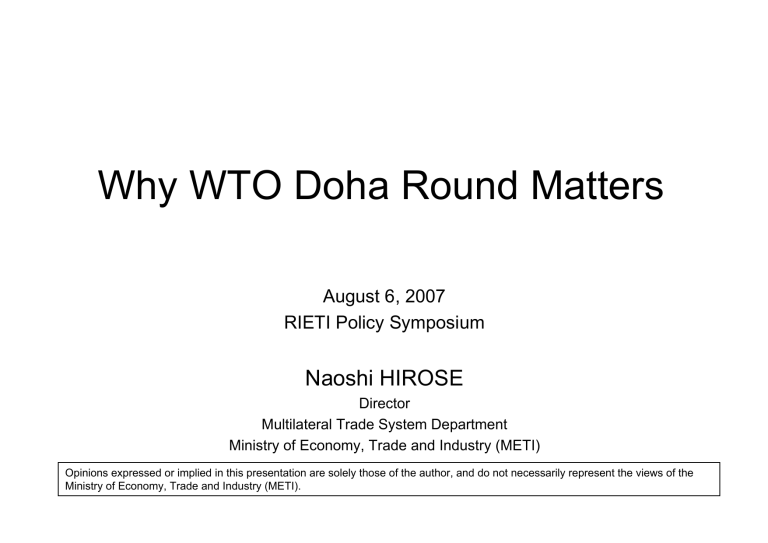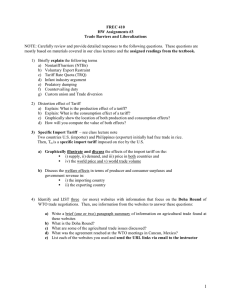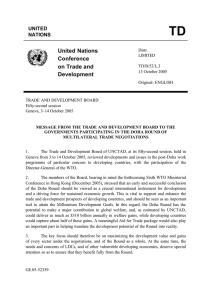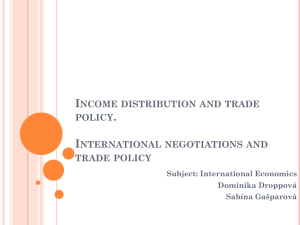Why WTO Doha Round Matters Naoshi HIROSE August 6, 2007 RIETI Policy Symposium

Why WTO Doha Round Matters
August 6, 2007
RIETI Policy Symposium
Naoshi HIROSE
Director
Multilateral Trade System Department
Ministry of Economy, Trade and Industry (METI)
Opinions expressed or implied in this presentation are solely those of the author, and do not necessarily represent the views of the
Ministry of Economy, Trade and Industry (METI).
Progress in the WTO Doha Round
The 4th
Ministerial
Conference
(Doha)
November,
2001
The 5th
Ministerial
Conference
(Cancún)
September,
2003
2002 2003 2004
The 6th Ministerial
Conference
(Hong Kong)
December, 2005
Adoption of
Hong Kong Ministerial
Declaration
2005
Re-start of the talks with technical work at the level of experts
November 16, 2006
Informal WTO
Ministerial Meeting
(Davos)
January 27, 2007
Return to full negotiation mode
Suspension of the Round
(The end of July)
2006
2007
Launch of the
Doha Round
Collapse of the
Conference
The General Council
July, 2004
Framework agreement
The General Council
February, 2004
Resumption of the negotiations
November 7 US midterm election
( The end of June )
Expiration of the
US’s TPA (Trade
Promotion Authority)
Agriculture, NAMA
Chairs’ texts
July 17, 2007
2008
1
Negotiating Areas
Agriculture
Substantial improvements in market access, reductions of all forms of export subsidies, substantial reductions in trade-distorting domestic support.
NAMA
Non-Agricultural Market Access
Reduction and elimination of tariffs as well as non-tariff barriers for all products other than agricultural products (e.g. industrial goods).
Services
Rules
Trade Facilitation
Liberalization of trade in services, with regards to restrictions on foreign equity participation, movement of natural persons, and cross-border supply of services.
Anti-dumping (AD), subsidies (including fisheries subsidies) and regional trade agreements (RTA).
Enhancing transparency, predictability and fairness of, and promoting simplification and acceleration of customs procedures.
Development
“Special and Different Treatment” ( S&D ) provisions, preferential treatment of Least-
Developed Countries (LDC), facilitating fuller integration of small, vulnerable economies (SVE).
In addition to the above areas, the negotiating areas of DDA include TRIPS (the establishment of a multilateral system for the notification and registration of geographical indications) and Trade and Environment.
2
Significance of the Doha Round for Japan
・
Reduce tariffs of developed and developing Members
-> New Trade Flows.
※ An example of simple average bound rate on non-agricultural products
・ Japan : 2.3%
・ U.S.
: 3.2%
・ EU : 3.9%
・ China : 9.1%
・ Brazil : 30.8%
・ India : 34.3% (Source : World Trade Report 2005 )
・
Support Japanese service sectors to access foreign service markets.
・
Strengthening international trade rules thereby improving predictability and preventing trade disputes.
(Failure in concluding the Round could lead to increase in international trade disputes.)
・
Trigger domestic structural reform in Member countries.
3
Positions of Key Members on Main Issues
Agricultural
Market Access
( Reduction of tariffs )
Defensive
Offensive
EU, Japan, India
→ realistic reduction sufficient flexibilities
Exporters
( U.S., Brazil, Australia )
→ High ambition 、 limited flexibilities
Agricultural
Domestic support
( Reduction of farm subsidies )
Defensive
U.S.
→ substantial reduction only if high ambition in market access
Offensive
Other than U.S.
→ Demand substantial reduction of U.S.’s subsidies
(
NAMA
Reduction of tariffs on
Non-Agricultural Products)
Defensive
Developing countries
→ Sufficient flexibilities
Offensive
Developed countries
→ Reduction with high ambition
4
NAMA Negotiation
1. Tariff levels in developed countries are low, but high tariff levels remain in developing countries.
High tariffs in advanced developing countries are especially of concern. Tariff reduction of developing countries encourages not only North-
South trade, but also South-South trade.
3. A simple Swiss formula with two coefficients should be adopted. The discussion is focused on the level of two coefficients.
40
Non-Agricultural Products : Simple Average Bound Rates of Countries [%]
34.3
30.8
30
24.2
20
15.8
10
9.1
10.1
11.0
2.3
3.2
3.9
0
Japan
Uni te d
St at es EU
Ch in a
Kor ea
Source : World Trade Report 2005
Au st ral ia
South
Af rica
Tha iland
Bra zil
In dia
2. Developing countries also maintain high tariffs for certain products.
( US ) Trucks : 25%
(EU) Consumer Electronics : 14%
Automobiles : 10% etc
< Changes in Bound Tariff Rates >
Countries
India
Brazil
China
United States
EU
Sample of Products
Machinery
Automobiles
Automobiles
Trucks
Consumer Electronics
Change of Bound
Tariff Rates [%]
40 → 10.9
35 → 10.5
25 → 9.4
25 → 7.1
14 → 5.8
( Calculation Condition )
Swiss formula coefficient : 10 for Developed Countries, 15 for Developing
( Calculated by Japan based on WTO Secretariat Sources.
)
4. Tariff reduction rates will be higher than in the
Uruguay Round if ambitious coefficients are applied.
・ Uruguay Round : One third (1/3) tariff reduction for developed countries.
・ Doha Round : (Average bound tariff reduction)
52.1% for developed countries (coefficient 10),
53.8% for developing countries (coefficient 15)
5
Trade in Services
1. The services negotiation aims to deregulate or abolish barriers to trade in services such as financial services, transportation, telecommunications, construction and distribution, etc.
Members make commitments how to deregulate or abolish their own barriers each other. Basically, the negotiation has been conducted with “request and offer approach” in which Members submit offers, reflecting requests from other Members.
2. Significant economic effects through increased efficiency in the service sector are expected.
The amount of world trade in services expanded from 783 billion U.S$ in 1990 to 2,415 billion U.S$ in 2005.
( International Trade Statistics 2006, WTO Secretariat )
3. Level of liberalization in developing countries is significantly lower than in developed countries, due to concerns from the viewpoint of promoting domestic industries and job security. However, in reality, liberalization has contributed to economic growth in developing countries. Furthermore, developing countries are requesting enhanced access of foreign workers into developed countries.
A hypothetical 25 per cent reduction of protection in service sectors will bring GDP gains in the amount of 2.9 per cent for
ASEAN countries and 1.4 per cent for India. ( ”OPEN SERVICES MARKETS MATTER” OECD 2001 )
4. The negotiation started already prior to this Round, but many Members have been unsatisfied because of low level of liberalization. Therefore, at the Hong Kong Ministerial in December 2005, Members agreed on the introduction of new mechanism which aims at further liberalization plurilaterally in specific sectors in addition to “request and offer approach” in which Members negotiate bilaterally.
5. Further, at the Hong Kong Ministerial, it was agreed that Members should submit second round of revised offers by the end of July 2006, which should contain higher level of liberalization. A new deadline has to be agreed upon by Members.
6
Rules: Anti-Dumping Negotiation
1. Anti-Dumping Negotiations
“Anti-Dumping (AD)” is a measure sanctioned by the WTO rule to cope with dumping; a situation in which the export price of a product is lower than its selling price in the exporting country. In recent years, the number of AD measures is increasing. In order to prevent Members from abusing the measures only for the purpose of protecting domestic industries, clarification and strengthening of AD rules are necessary.
2. The number of AD measures still remains high. Abuse of AD measures is a common issue among developing and developed countries.
250
200
150
100
50
0
Worldwide trend of AD Measures
119
92
125
170
185
227 216
167
221
151
131
137
95 96 97 98 99 00 01 02 03 04 05 06
1
Top 10 countries/areas by the number of AD measures (1995 ~ 2006)
Number of AD measures imposed by Number of AD measures taken against
India 331 6 Turkey 107 1 China 375 6 Russia 84
239 7 92 2 Korea 136 7 Thailand 76 2 U.S.
3 EC
4 Argentina
231
152
8
9
China
Canada
Mexico
84
82
3 Chinese
Taipei
4 US
107
104
8 India
9 Indonesia
75
73
5 South
Africa
120 10 Australia 71
5 Japan 97 1
0
Brazil 69
3. Abuse of AD measures undermines the effects of reducing tariffs and liberalizing market access. It is necessary to strengthen the AD rule to establish a predictable trading environment.
Average applied tariff rate and Average AD duty rate
The level of Average AD duty rate is around five times as Average applied tariff rate.
Average applied tariff rate of WTO Member countries : 10%
(as of 2005 )
Average AD duty rate against Japan : 49%
( 2005 ~ 2006 average )
◆ Example caused by AD measures:
There are cases in which AD measures remain in force for decades.
e.g. maximum 33 years on Polychloroprene Rubber, 18 years on ball bearing.
7
Trade Facilitation
1. Negotiation on Trade Facilitation is to enhance the physical distribution of goods and decrease cost of trading etc. through improvement of trade procedures.
Example of Problems in Trade procedures
- Lack of transparency and predictability in trade regulations
- Lack of uniformity in operations
- Complicated procedures of import-export trade
- Excessive documents requirements
Solution
Securing transparency ( Publication of trade regulations,
Appeal procedures etc.
)
- Simplification and harmonization of trade-related procedures
- Special and differential treatment (S&D) for developing countries (Capacity building etc.)
2. Negotiation on Trade Facilitation aims to clarify and improve aspects related to GATT Articles V, VIII and
X for smooth transport and trade-related procedures, as well as to strengthen capacity building.
3. Merits of trade facilitation is widely acknowledged by Member countries including developing countries..
Negotiation are going on based on textual proposals.
8
Development
1. DDA is a “Development Round “.
- 80% of all 151 WTO Member are developing countries (121).
- 30 developed countries (OECD member countries) out of WTO members countries.
2. Special Treatment for developing countries throughout negotiation areas.
- Agriculture and NAMA negotiation: Differentiated reduction commitments and flexibility for agriculture domestic support and market access and NAMA market access.
- Developing countries are requesting enhanced Special and Differential Treatment (S&D) provisions in WTO
Agreements. Members have also discussed ways to assist developing countries so that they can reap more fully the benefit from the multilateral trading system.
3. Members agreed in Hong Kong Ministerial Conference (Dec. 2005) on Special and Differential Treatment for LDC products such as duty-free and quota-free market access. Developed countries also announced their “Development Packages”.
- Development Packages
Japan (Development Initiative for Trade):
- Allocate no less than $10bn over the next three years for infrastructure development related to trade, production and distribution.
- OVOP (One Village One Product) campaign to provide assistance to developing countries with a view to enhancing their capability, improve and export their promising products to international markets.
- Expand Duty-Free Quota-Free market access to Japan from LDCs up to 98% of tariff lines (starting April 2007).
USA: More than double its contribution to global Aid for Trade ($1.3 billion in 2005 -> $2.7 billion in grants annually by 2010.
EU: Provide 2 billion in aid for Trade as of 2010.
9
Trade Flow and Benefits for Developing Countries
• Trade by developing countries is growing, especially South-
South Trade.
- Trade (share in total world trade)
From -> To 1990 2005
Developed -> Developed 55.1% 39.5%
Developed -> Developing 16.6% 17.2%
Developing -> Developed 16.9% 22.2%
Developing -> Developing 9.8% 19.9%
(Source: IMF DOT (Direction of Trade Statistics) 2006)
- Trading partners for developing countries
1990
Developed countries 77%
Developing countries 23%
2005
66%
34%
10
Why We Need Multilateral Negotiation at WTO
•Able to achieve market liberalization from 151 countries at the same time.
•Each country has different offensive interests and defensive interests. ->
The web of “gives and takes” among countries are extensive and complex.
-> Lengthy negotiation is necessary, but once agreement is reached, possibility that a large package is achieved.
•Countries with less negotiating power (e.g. small developing countries) can nevertheless obtain concessions from big-power countries.
•Creating and Improving trade rules (e.g. reducing and/or eliminating subsidies, clarifying and improving anti-dumping rules) can only be negotiated multilaterally.
•Negotiated results can be enforced by the WTO Dispute Settlement
Mechanism.
11
High-level Political Commitment
13th Meeting of APEC Ministers Responsible for Trade
Statement on Doha Development Agenda
Cairns, Australia, 5-6 July 2007
(Excerpt)
We acknowledge the singular importance of ensuring the continued strength and openness of a rules-based global trading system which operates to provide expanding economic opportunities. We strongly re-affirm our commitment to a successful conclusion of the Doha Round negotiations this year.
We emphasise that a successful Doha outcome must deliver meaningful new market opportunities in order to significantly expand trade, promote global economic growth and foster development. We all undertake to contribute. We will demonstrate the necessary political will and flexibility, and call upon other WTO
Members to do the same. To this end we will engage actively and constructively in the negotiations in Geneva.
We reiterate that consensus can only be achieved through an ambitious and balanced result that brings new trade flows in agriculture, industrial goods, and services, thereby securing benefits to all, in particular developing country economies.
12
Road towards Convergence
• Multilateral Process
(Negotiating Group meetings, formal or informal) vs
Small Groups
(G4, G6, ……)
• High-level talks (minister-level) vs
Technical-level discussion
• Role of Chairs’ texts
13
Thank You
14




